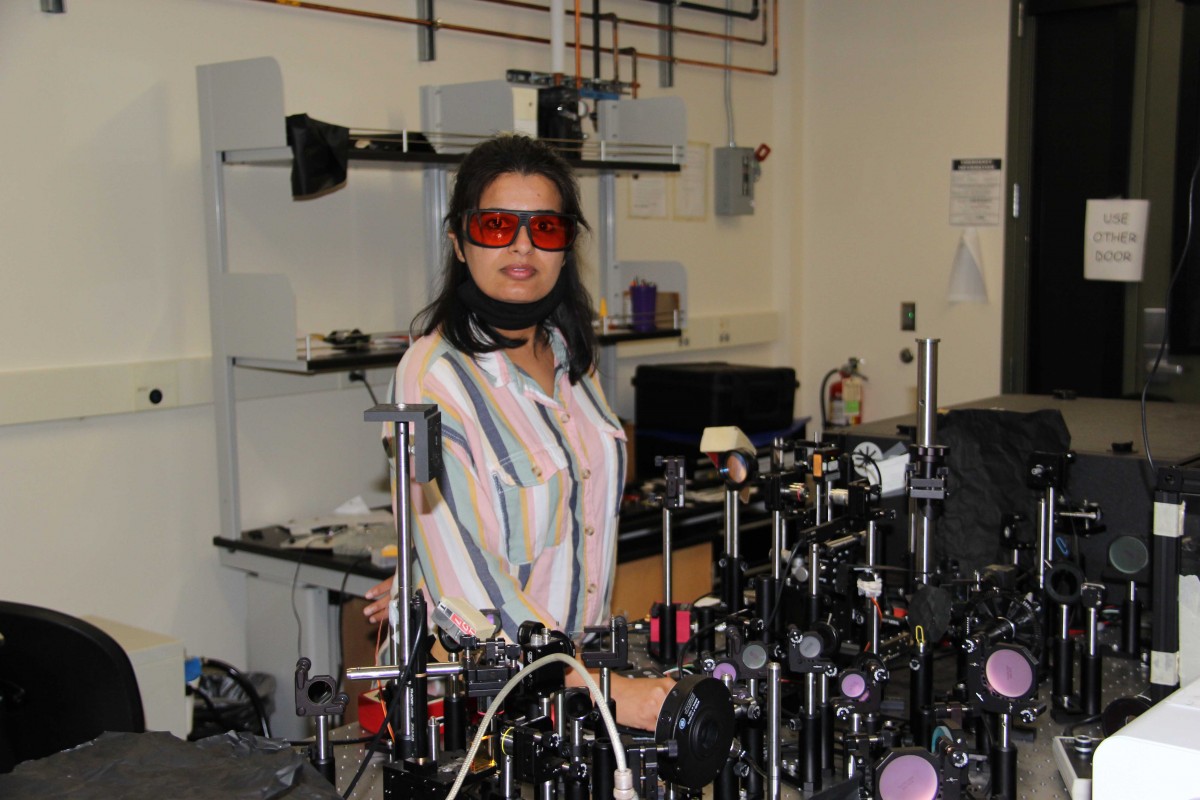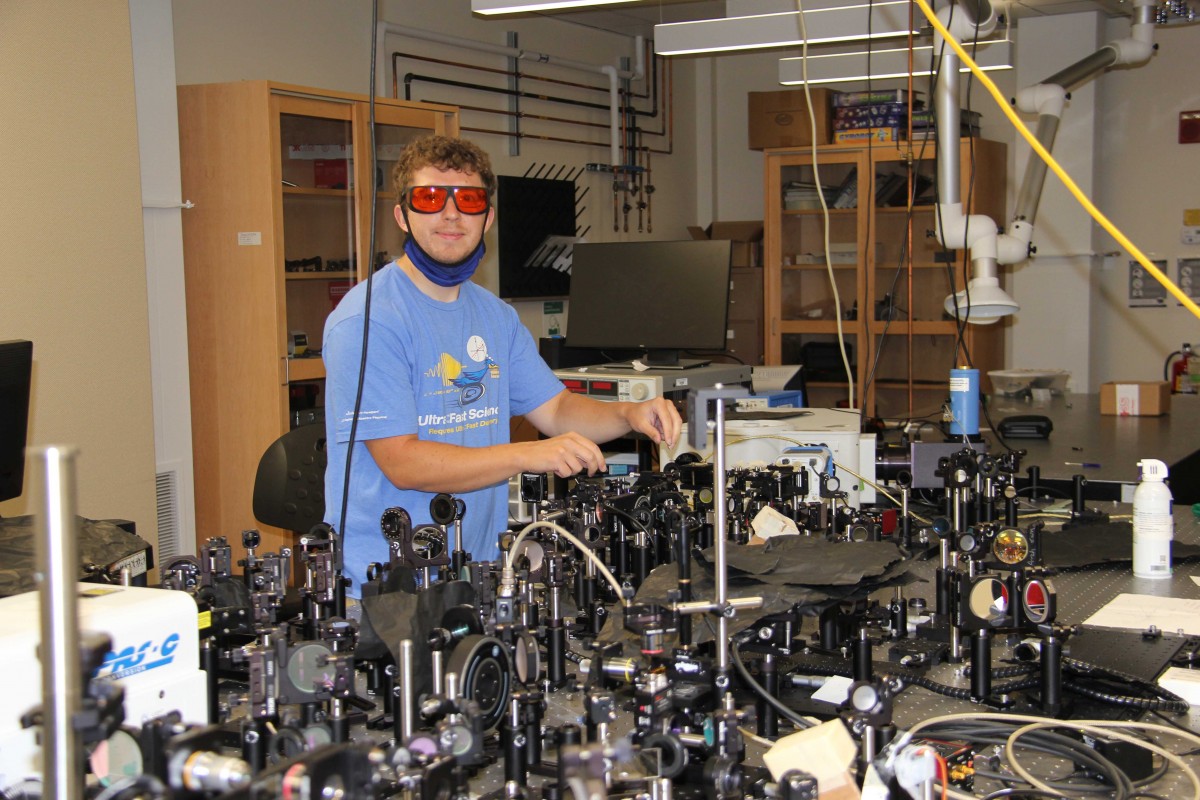A fraction of a second: Physics lab captures the first single-shot snapshot of glass ionization

Grab your best camera and try to shoot a small object in motion — a baseball struck by a bat, perhaps. Can you capture the moment after the strike, when the ball begins its arc toward the stands, without a motion blur?
Photographing sports can be challenging for even seasoned professionals, who need to invest in top-notch camera equipment with fast shutter speeds. Now shrink that ball down to the size of an atom, ramp up the speed of its travel — and you’ll begin to understand the challenges that Associate Professor of Physics Bonggu Shim and his research team face.
Shim and doctoral students Dennis Dempsey and Garima Nagar capture images of an incredibly tiny and fast phenomenon: the creation of plasma when an intense laser pulses through glass. Using a state-of-the-art ultrafast camera method called frequency-domain holography (FDH), they were able to capture the first single-shot snapshot of an intense laser pulse interacting with atoms and molecules in a pane of thin, flexible glass supplied by Corning Inc.
“Our work is, to the best of our knowledge, the first single-shot visualization of glass ionization,” Shim said.
Dempsey and Nagar are lead authors, in collaboration with James Sutherland from Corning Inc., for the recently-published article on their work, “Single-shot ultrafast visualization and measurement of laser–matter interactions in flexible glass using frequency domain holography,” in the March 2020 issue of Optics Letters.
Dempsey and Nagar also won first prize in the energy technical group poster competition at Conference on Lasers and Electro-Optics, one of the largest laser/optics conferences in the world, in May 2019. Eight months prior to that, they won the student poster competition at the 30th annual Electronics Packaging Symposium.
The research group’s work is currently funded by federal agencies: the U.S. National Science Foundation (NSF) and the Air Force Office of Scientific Research. Their findings have the potential to affect not only the scientific understanding of ionization, but to lead to new industrial applications.
“This plasma and laser physics research group at Binghamton University has demonstrated how to leverage collaborations with local industry for studies of fundamental physics phenomena,” said Vyacheslav (Slava) Lukin, a program director in NSF’s Division of Physics. “It is important to maintain two-way collaborations between academia and industry, benefitting both and providing students with first-hand exposure to the variety of possible STEM careers.”
When a material interacts with a laser, changes occur in the tiniest fraction of a second. Seeing and understanding those changes is critical for the development of laser applications, Shim explained. Fortunately, one of those applications is the creation of ultrafast photographic tools such as FDH.
“Lasers are now used everywhere in academia and industry as tools for material processing, device fabrication and even laser fusion,” Shim said.
Super-small and super-fast
Frequency-domain holography (FDH) allows the researchers to take snapshots of intense laser-matter interactions on the femtosecond level, or one quadrillionth of a second. That’s one millionth of one billionth of a second, an unimaginably short segment of time.
No conventional camera exists that can take images on a femtosecond scale. To photograph the motion of electrons in atoms and molecules, you need to use special methods.
One conventional method uses two laser pulses: The first, called the pump, causes ionization while the second, called the probe, captures the images with a controlled time delay. Unlike FDH, this method requires multiple shots, which can require additional material for each snapshot and a longer time to map out the evolution of the laser-matter interactions.
Shim learned the FDH technique from its developer, Professor Michael Downer at the University of Texas at Austin, when he was Downer’s graduate student. Essentially, FDH captures the time evolution of an event with a single laser shot.
Here’s how it works: Laser light has a specific color, characterized by its wavelength; ultrashort laser pulses on the femtosecond scale have multiple colors. In FDH, those colors travel at different times, a technique known as “pulse chirping.” Those chirped pulses can record an event at different times, which is why they are used to “make movies,” Shim explained.
While the technique was previously used for a single-shot visualization of gas ionization, Nagar and Demspey’s experiment marked the first time it successfully captured glass ionization — a process that unfolds differently because glass is typically a thick solid. The nature of glass complicates matters in other ways: It broadens the laser beam due to an effect called dispersion, which complicates the time resolution needed to capture an image.
“For instance, if you want to take a clear picture of a fast train, your camera exposure time should be very short,” Shim explained. “Otherwise, if the camera exposure time is long, the picture looks blurry because the train moves while the camera is taking a picture.”
Enter the specially made glass from Corning, the lab’s partner on the project. At only 100 to 200 micrometers thick, the flexible glass proved the ideal medium for the experiment.
“James Sutherland of Corning and I have been collaborating on a couple of projects thanks to the support of Integrated Electronics Engineering Center of Binghamton University,” Shim said.

